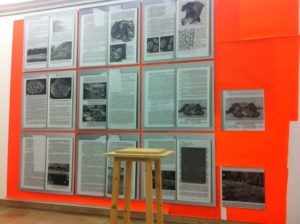The legendary documentary Degenerate Art: The Nazis vs. Expressionism is available now (and probably not for long, so, Greasemonkey extension for Firefox, if you know what I mean) on youtube. Part of the mythical status of this program that originally aired in 1993 on the BBC is that it was never converted from VHS to DVD or digital download and has thus been difficult to locate and view.
As you might guess from the title this documentary by David Grubin is about the famous 1937 art exhibit held in Munich called Entartete Kunst, intended by the Nazis to show, collected, the most non-enobling effects of “degenerate art.” (Der Turm der blauen Pferde was part of this exhibit in Munich, and then removed when the show traveled to Berlin, beginning its period of being missing and presumed destroyed. I wonder sometimes if it would make Franz Marc scholars more happy or more sad if it is ever recovered…).
Scrutiny 20 years hence reveals some wobbles, such as overly sympathetic dwelling on Emil Nolde and Max Beckmann and an art-historically non-critical narrative (which you would be on the edge of not expecting in 1993).
However what makes this documentary astonishing and very worthwhile watching is the amazing film footage and few still photographs (most provided by the Los Angeles County Museum of Art which had an exhibit based on Entartete Kunst in 1993 also) showing much of the confiscated work but also of the Hitler-approved art across the street at the (then) Haus der deutschen Kunst. The huge halls contain, in this archival footage, actually very few works of any kind and thus the monumental hairless nude sculptures such as Arno Breker’s Preparedness are all the more scary, the paintings of motionless naked women more pornographic.
The complete collection of Entarte Kunst is archived online at Universität Berlin’s excellent online gallery devoted to the subject. Also, the credits at the end of the film list all of the works shown in both exhibitions, and identify all of the images and photos, so this in itself is a very valuable resource.
httpv://www.youtube.com/watch?v=1QE4Ld1mkoM
In the present, I am really beginning to become very fond of Haus der Kunst, inclusive of the exhibits installations I have seen there thus far, of the space itself, and of the demeanor and talents of the curators. The next time I am on an airplane with Okwui Enwezor I will give him all the in flight snacks I can hoard plus any frequent flyer miles I might have on tap…
The occasion for the most recent visit back at the beginning of the month was a preview of one iteration of the tri-partite exhibition (it is simultaneously up and not-the-same in Brussels and Bristol) WORLD[K] IN PROGRESS? by Belgian artist Joëlle Tuerlinckx. I often hear Tuerlinckx’s work (even by herself) characterized as “conceptual,” but I think this unfairly sets up an expectation that the visual manifestation will be incomprehensible, or simply unattractive, à la Sarah Sze. (Tuerlinckx’s version of conceptual is actually somewhat literal, in the sense that she expands upon a concept suggested by the mind’s eye and makes it concrete – during the preview tour Tuerlinckx was able to easily explain how an excised Matisse goldfish journeyed from her memory to a bright, unframed cut-out and of course the reference to the source material is likely identifiable to most people who will see it. The same can be said of most of the drawings, newspaper clippings, geological specimen display cases, collages, found objects (such as ladders and ropes), and even open-ended video segments of people walking endlessly through corridors – the base aesthetic is referential, however complex the artist’s motivation may be. Tuerlinckx says that she is mainly concerned with provoking questions about the inconsistency of our perception of time.
Perhaps it is the brilliant curation of this exhibit by Julienne Lorz, which breaks up Haus der Kunst’s shotgun-lengthed halls into slightly more evenly square units, or the freight of historical aura, but many of the discrete objects in WORLD[K] IN PROGRESS? made me quite unaware of the passage of time as I lost myself in it inspecting definitions from old dictionaries or being absorbed into cathode-ray-tube projections, which are themselves non-ironic artifacts of the recent past.
At the introduction to the works Lorz and Tuerlinckx conversed together and answered questions in French and German, displaying an ease with each other that was very refreshingly genuine compared to the normal massive falseness of these types of arranged meetings. Of course the role of the curator is very much an au courant academic subject which I will not get into here, but on the most basic level, Lorz and Tuerlinckx showed that two women seated on straightback chairs speaking softly for 30 minutes through content with which they are completely and generously at ease is really quite captivating.


 RSS - Posts
RSS - Posts